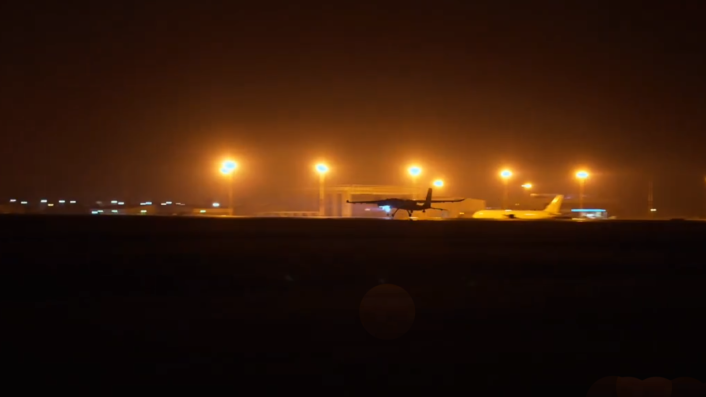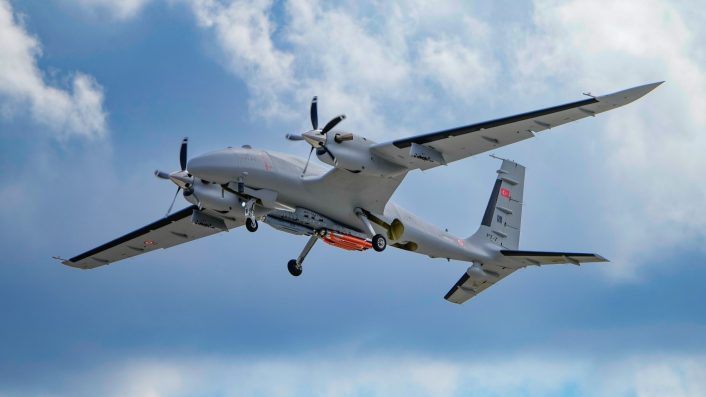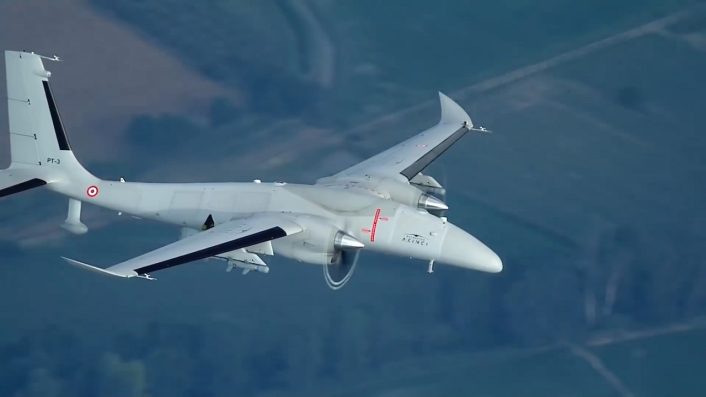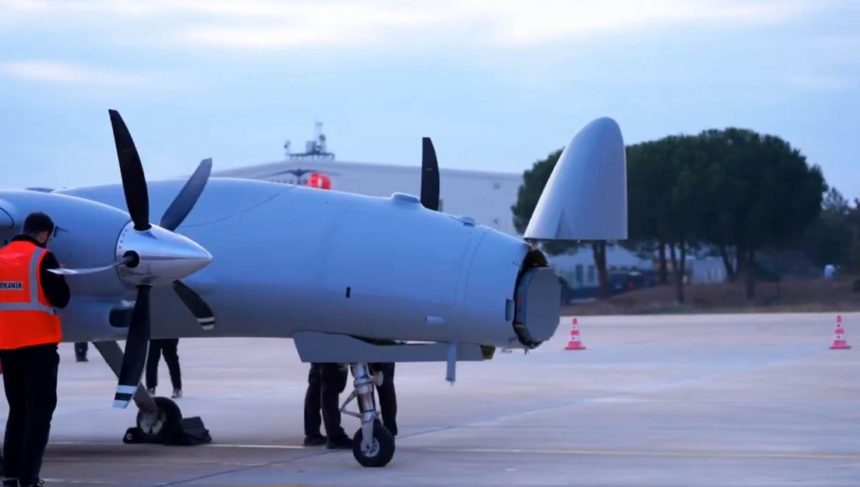Equipped with the new MURAD AESA radar, the Akıncı can track both aerial and ground targets, paving the way for a future in an air-to-air role with the integration of the indigenous Bozdoğan and Gökdoğan AAMs.
Turkey’s Bayraktar Akıncı UCAV (Unmanned Combat Aerial Vehicle) completed its first flight with the MURAD AESA (Active Electronically Scanned Array Radar), the company announced. The official video released online showed the Baykar-operated Akıncı-A “PT-3” with the nose cone opened and the radar array visible during pre-flight checks by the ground crew.
The test took place at night, with footage from inside the control station briefly showing radar blips on the screen, indicating the drone has detected contacts. Flight parameters were not released, but another shot of the main control screen showed the drone in level flight at an altitude of 24,997 feet.
The integration of the MURAD radar on the UCAV represents a first step towards the introduction of air-to-air capabilities. The Aviationist observed in previous reports that the Turkish military aviation is heading towards using UCAVs for standoff air-to-air roles, by using the indigenous radar and weapons like the Bozdoğan and Gökdoğan AAMs. Roughly 300 of these missiles have been reportedly delivered.

Turkish defense profiles reported in Dec. 2023 about MURAD being integrated on Akıncı, with one quoting Aselsan’s general manager Ahmet Akyol announcing the capability to use the two above-mentioned missiles. “Both the platform and the radar” were also claimed to have been “revised,” suggesting software and interface modifications before the test.
Kimse gökyüzünde dokunulmaz değil…
Oyunun kuralları değişiyor. ⏳
Yarışmacı arkadaşlara başarılar diliyoruz. #AKINCI #MURAD https://t.co/JNhd7l2jZB pic.twitter.com/rNSpHEdBZB
— SavunmaSanayiST.com (@SavunmaSanayiST) March 1, 2025
MURAD 100-A
According to ‘Oğuzhan Uygun’, the Aselsan MURAD 100-A can scan for targets at ranges of 200 km, with both “all aspect” and “high-aspect” search. The air-to-air capabilities include midcourse guidance for missiles, high-aspect search, helicopter detection, and weather mode, according to Aselsan.
Air-to-surface capabilities include SAR (Synthetic Aperture Radar) imaging, ground-moving target indication, fixed target tracking, mapping, EW (Electronic Warfare) functions and rangefinding. The product’s data mention it uses a wide frequency band, but it is not yet clear what band the radar operates in – whether S or X-band. Aselsan also says that MURAD uses GaN (Gallium Nitride) technology, as transceivers made with the material have higher electromagnetic sensitivity.
Bayraktar #AKINCI ✈️🐳🚀
✅ Murad AESA Radar ile Test Uçuşu
✅ Test Flight with Murad AESA Radar#Baykar 🤝 @Aselsan#MilliTeknolojiHamlesi 🌍🇹🇷 pic.twitter.com/gPgy7fd3sl
— BAYKAR (@BaykarTech) March 1, 2025
In addition to the Akıncı, the MURAD 100-A is slated to be installed on the Kizilelma, Anka III, Hurjet, Kaan and the Turkish Air Force’s (Türk Hava Kuvvetleri) and TAI’s (Turkish Aerospace Industries) domestic F-16 upgrade project called Özgür, as per a video and post shared on X by ‘Avionot’. Özgür initially involved upgrading 35 of around 200 F-16 Block 30/40/50s, and now is being extended to nearly the entire fleet, as Ankara decided to substitute importing 79 upgrade kits from the U.S. in favour of its own indigenous electronics, avionics and sensors.
The commonality in having the same domestically-made radar across manned and unmanned platforms has benefits both in manufacturing, maintenance, logistics, repair, costs and even tactics. Naturally, Aselsan would develop advanced and improved variants following experience and lessons from the current variant. The company’s website talks about the MURAD 110-A, depicted in a rendition with a heavily air-to-air and air-to-ground kitted TAF F-16.
ASELSAN MURAD AESA Radar sistemi Akıncı TİHA ve adı açıklanmayan bir jet uçağına entegre edildi.
Akıncı üzerinde testler yapıldı ve hu testler sonucunda hem platformda hem de radarda revizeye gidildi. pic.twitter.com/eALfgbX0Mb
— Yusuf Akbaba (@ssysfakb) December 31, 2023
Rare global achievement
According to Haluk Haluk Görgün, chief of the SSB (Presidency of the Defense Industries), the drone’s “successful […] first flight” with the MURAD AESA radar is a “groundbreaking success,” affording Turkish drones “sharper eyes, superior mission capability in all conditions, and game-changing capabilities in the field.”
Calling the Akıncı “one of the biggest” HALE (High-Altitude Long-Endurance) UCAVs in the world, Daily Sabah said the aircraft can now undertake roles and operations “otherwise done by fighter jets.” Quoting Baykar officials, the report further mentioned the drone “carries electronic support systems, dual satellite communication systems, air-to-air radar, collision avoidance radar and synthetic aperture radar.”

This would allow the unmanned aircraft to go well beyond its basic ISR-strike role. Aselsan added that this “game-changing technology, which only a few countries in the world have been able to develop, will contribute greatly to Akinci’s air dominance and situational awareness.”
The company said Akinci utilizes the Murad 100-A’s “state-of-the-art multifunctional” fire control capability that can simultaneously scan for air and ground targets with “agile electronic beam steering capability.” Daily Sabah further added that, “considering the growing role of uncrewed aerial vehicles (UAVs) on the battlefield, the Murad 100-A radar, which can be integrated into both fighter jet aircraft and UAVs, is indispensable for all aircraft to ensure operational superiority in air warfare.”
Tactical use
As explained in previous reports here at The Aviationist, the use of slow-moving UCAVs, even with control latency, limited maneuverability and airframe constraints on carrying heavy aerial combat electronics, becomes feasible if an air force has a large fleet of fourth generation fighters, AEW&C aircraft and aerial refuelers that can work with the unmanned assets.

This allows enforcing a form of aerial denial in low-risk sectors, where the AAM-carrying UCAV can restrict enemy aerial operations and significantly unburden manned fighters from CAPs (Combat Air Patrols), thus freeing them up for offensive roles.
Additionally, the Akıncı could also effectively double as an airborne early warning platform with its AESA radar, acting as both an offboard sensing and weapons release aircraft. The UCAV can also provoke both enemy aircraft and SAM radars into exposing their positions if they attempt to engage it.









